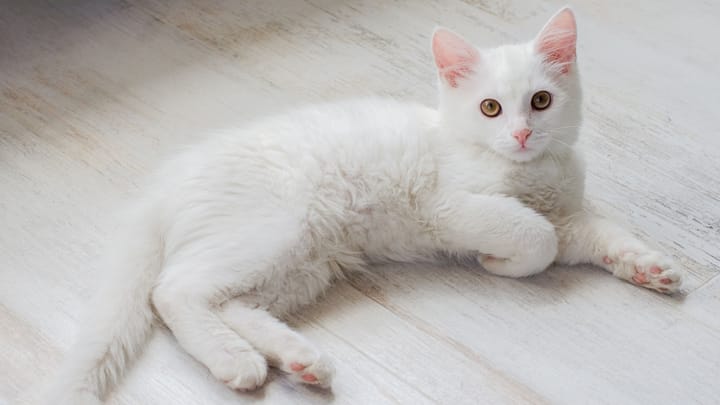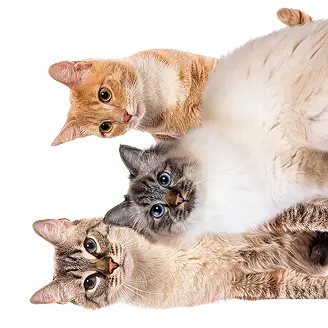Turkish Angora


The origins of this cat with mid-length fur date back more than 2000 years in East Asia. Their graceful gait and vaporous fur even charmed the French monarchy at the time of the sun king. Lively, curious and mischievous, they also enjoy moments of tenderness with members of the family. The Turkish Angora has a rather strong character; they know what they like and dislike, and anyone who goes against the will of Turkish Angora, beware!
|
Life expectancy |
The Turkish Angora has a life expectancy of between 15 and 18 years |
|
Temperament |
|
|
Adult size |
Female
Between 12 and 13 in
Male
Between 12 and 13 in
|
|
Adult weight |
Female
Between 4 and 11 lb
Male
Between 4 and 11 lb
|
|
Coat colour
Black / seal, blue / grey-slate, ginger, white All colours are recognised by the GCCF except chocolate, lilac, cinnamon et fawn. |
Black White Red Blue |
|
Type of coat
Mid-length |
Long |
|
Eye colour
Blue, aquamarine, green, golden yellow, walleyed |
Blue
Green
Yellow
Odd-eyed
|
|
Purchase price |
The Turkish Angora costs between £150 and £200 |
The Turkish Angora is an excellent life companion that loves being stroked and playing games. It does however have a strong temperament that must be treated with respect and kindness.
More details about the Turkish Angora
Turkish Angora: Origins and history
As its name suggests, the Turkish Angora originates from ancient Ankara, also called Angora, more than 2000 years ago. Imported to Europe in the 17th century by Pietro della Valle and Nicolas de Peiresc, this elegant cat with silky, mid-length fur quickly became the muse of artists and great European monarchs, who later discovered long-haired cats. Unfortunately, some dangerous cross-breeding led to the loss of its basic characteristics. The Second World War and the Turkish export ban almost got the better of this cat, but nobody was counting on the tenacity of an American couple, Mr. and Mrs. Grant, who are the originators of the modern Turkish Angora. It was not until the 1970s that this breed was officially recognised.
Physical characteristics of the Turkish Angora
The Turkish Angora is an average sized cat with a slim and athletic build. It has a fluid and gracious gait. Its head is triangular, with quite large ears, both wide and tall. It has a long, slender and muscular body. Silky and fine, its mid-length fur has little undercoat. Its hairs are longer around the collar, chest, stomach and tail. Its slender legs are slightly longer at the back. Its eyes are almond shaped or sometimes round.
Turkish Angora: Characteristics
Turkish Angora: Behaviour
Breed compatibility Turkish Angora
Turkish Angora: Purchase price
On average the price of a Turkish Angora kitten is between £150 and £200, the price varies depending on lineage, age, provenance and even gender. It costs on average £30/month to provide for its needs, to offer a quality diet and ensure it is healthy.
Turkish Angora: Shedding
Average
Brushing should be more regular during the summer moult. This cat can lose a large amount of hair at that time but regular brushing will maintain a beautiful coat.
Turkish Angora: Grooming
The Turkish Angora does not have an undercoat, its fur does not have any particular grooming requirements, other than a weekly brush.
Turkish Angora: Health
This cat can live for 15 to 18 years. Because this is such an active cat, some can even live a few years longer.
The Turkish Angora is a robust cat with a mid-length fur and little undercoat, which is thicker around the neck and stomach, helping him resist the cold and the heat.
This cat does not have a specific tendency to put on weight, but as with most cats, it requires activity and stimulation to use up its energy and maintain a healthy weight. Adapting its diet depending on age and activity levels will also help avoid him becoming overweight.
Its robustness makes him subject to no particular disease. However, an annual checkup with the vet is advised; he may, despite everything, develop the same illnesses as any other cat such as oral diseases.
Young Turkish Angora’s reach sexual maturity around 8 to 12 months. Pregnancy usually lasts 56 to 71 days with litters of between 3 and 5 kittens.
Mating two white Turkish Angoras usually leads to deaf kittens.







